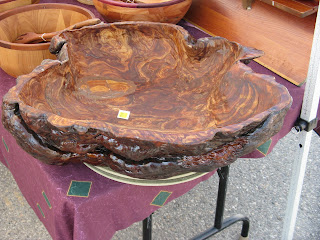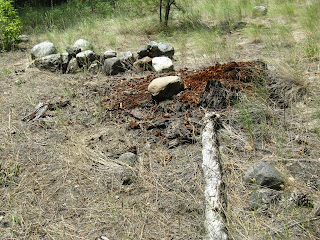
Taking EDST 588, getting involved with The
And we pray, not
for new earth or heaven, but to be
quiet in heart, and in eye,
clear. What we need is here.
When many of us are so concerned with our next vacation, job, purchase, or what we have to do to "keep up with the Joneses", we forget that what is around us – the beauty and abundance of our natural environment – is all that we really need. If we simply allow ourselves to be immersed in nature, spending quiet, quality time in our "here", we will find what we need. We will find beauty, meaning, shelter, food, recreation...the possibilities are numerous. We could focus on the scads of human refuse scattered recklessly in our woods and trails; we could grumble at the graffiti on signs and trees; we could choose to harp on the damage human-caused fires have done, or the constant noise of construction that invades the
Our nature site visits, our field notes, and our sharing allowed me to open my mind, heart, and soul to nature and my place as a part of nature's intercon





 Being a part of The Learning Garden has made me realize a few things about my teaching, my learning, and my lifestyle. First of all, working as a group of equals who made decisions together made me reflect on how I teach. Typically, it's in a situation where I maintain high levels of control and my students create mostly individual products to be assessed by me to determine if they learned particular outcomes. While sometimes this is necessary, it is not always the best, or the most enjoyable, way to teach and learn, as it is very restrictive, controlled, and solitary. Furthermore, I came to realize that the teaching and learning that I and my students do is more often than not separate from the natural world - yet it need (and should) not be. As Orr (1999) said in his essay What is Education For?, "By what is included or excluded we teach students that they are part of or apart from the natural world." My mission is to include the natural world in the lessons and units I teach. Orr also aptly stated that "Indoor classes create the illusion that learning only occurs inside four walls", a notion which could not be further from the truth. We learn wherever we are, and taking classes outdoors as part of EE 588 was extraordinary and beneficial. I gained immense pleasure, enjoyment, insight, relaxation, and fulfillment during my time spent learning outside, whether it was digging in the garden, climbing up steep, arid hills, or sitting quietly in a wooded thicket, writing, and later sharing, our thoughts and observations. I now realize that learning is not about the place; it is more about a state of mind and an understanding of the interconnectedness of all things in the world.
Being a part of The Learning Garden has made me realize a few things about my teaching, my learning, and my lifestyle. First of all, working as a group of equals who made decisions together made me reflect on how I teach. Typically, it's in a situation where I maintain high levels of control and my students create mostly individual products to be assessed by me to determine if they learned particular outcomes. While sometimes this is necessary, it is not always the best, or the most enjoyable, way to teach and learn, as it is very restrictive, controlled, and solitary. Furthermore, I came to realize that the teaching and learning that I and my students do is more often than not separate from the natural world - yet it need (and should) not be. As Orr (1999) said in his essay What is Education For?, "By what is included or excluded we teach students that they are part of or apart from the natural world." My mission is to include the natural world in the lessons and units I teach. Orr also aptly stated that "Indoor classes create the illusion that learning only occurs inside four walls", a notion which could not be further from the truth. We learn wherever we are, and taking classes outdoors as part of EE 588 was extraordinary and beneficial. I gained immense pleasure, enjoyment, insight, relaxation, and fulfillment during my time spent learning outside, whether it was digging in the garden, climbing up steep, arid hills, or sitting quietly in a wooded thicket, writing, and later sharing, our thoughts and observations. I now realize that learning is not about the place; it is more about a state of mind and an understanding of the interconnectedness of all things in the world.
Throughout the EE course, Dr. Gaylie chose to guide rather than direct, inviting us to have input into the direction the class took. We discussed and agreed upon everything, including our daily work in the garden, our nature site visits, and our "legacy" we wanted to leave behind. It was an extremely refreshing experience to have a teacher, a PROFESSOR, give us choice in what we learned and worked on. I will certainly take this cooperative teaching and learning experience with me as I continue to grow as an educator. We all contributed to projects, such as building birdhouses, that would not have been possible for several of us had we set out as individuals. Knowledge, confidence, the right tools...all of these potential obstacles were overcome as a group. We learned together, as a whole unit. Now I more clearly see that the teaching and learning process happens in a community, rather than as individuals, and I will use this small-group model with my students.
As far as my lifestyle? Well, though I have a house with landscaping that my wife, parents and I worked on, we do not currently have a garden. We enjoy working outside and getting our hands into the cool, crumbly earth; however, we landscaped the small area that was for a brief time our garden. It wasn't well-lit or very expansive, true, but we simply felt it wasn't worth the time and effort to maintain. Now that we have two young girls, our thoughts have changed yet again. We can see the myriad benefits: physical exercise, a spiritual connection with the land, fresh, nutritious food to eat, and, of course the family bonding and learning together that occurs when working on a garden. We' re also looking at taking some baby steps towards reducting our footprint on the earth. I found some great "beginners" tips here on the Suzuki Foundation site.
Next year, we're planting a garden. It might be just a few planters, but after seeing the excitement in my 2-year-old daughter's eyes when she got to water "her" strawberry plant at her Nana & Papa's, I am convinced - it's time to plant a garden. Here. After all, what is here is the sun, the earth, seeds, water, our hands, hope, love, learning, sharing, and each other, and those are the things that make a garden grow.


























































